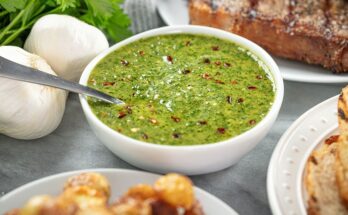Udon Recipe: Udon is a type of thick, chewy Japanese noodle made primarily from wheat flour, water, and salt. Renowned for its satisfying texture and versatility, udon can be enjoyed hot or cold and served in a variety of broths or dipping sauces. Whether it’s a comforting bowl of hot udon on a chilly day or a refreshing chilled noodle salad in summer, udon adapts beautifully to seasonal ingredients and personal preferences. The texture of udon is what makes it so special—soft yet bouncy, giving you a pleasant bite that complements rich broths and flavorful toppings.
Origins and Cultural Significance of Udon
Udon has a deep-rooted history in Japanese cuisine, believed to have been introduced by Buddhist monks from China over a thousand years ago. Over time, it evolved into a staple food across Japan. Each region has its own take on udon, such as Sanuki udon from Kagawa Prefecture, known for its firm texture, or the flat and wide Kishimen noodles of Nagoya. Culturally, udon isn’t just a meal—it represents comfort, hospitality, and tradition. It’s commonly enjoyed during festivals, as part of celebratory meals, or simply as a quick lunch or dinner solution.
Ingredients Needed for Udon
For the Noodles
To make traditional udon noodles from scratch, you’ll need just three simple ingredients:
- 2 cups all-purpose flour
- ¾ cup water
- 1 teaspoon salt
These ingredients are easy to find but require a specific preparation method to achieve the iconic texture of udon. Using bread flour or a combination of flours can yield even chewier results, and some modern recipes incorporate kansui (alkaline water) for an extra bounce, although it’s not traditional.
For the Broth
The heart of a good bowl of udon is in the broth. The most traditional broth is a dashi-based soup made from kombu (dried kelp) and katsuobushi (bonito flakes). Here’s what you’ll need:
- 4 cups water
- 1 piece kombu (about 10cm)
- 1 cup loosely packed bonito flakes
- 2 tablespoons soy sauce
- 1 tablespoon mirin
- 1 teaspoon sugar
This mixture provides an umami-rich base that highlights the clean, wheat flavor of the noodles.
Optional Toppings and Garnishes
Udon is incredibly customizable. Here are some popular toppings:
- Thinly sliced green onions
- Tempura (shrimp or vegetables)
- Kamaboko (fish cake)
- Soft-boiled or poached egg
- Nori strips
- Togarashi (Japanese chili flakes)
- Wakame (seaweed)
These toppings add texture, flavor, and visual appeal to your bowl.
How to Make Udon Noodles from Scratch
Mixing and Kneading the Dough
Start by dissolving the salt into the water completely. In a large bowl, add the flour and slowly pour in the saltwater while stirring with your hand or a wooden spoon. As the dough begins to form, knead it in the bowl until it starts to come together. Then transfer it to a clean surface and knead vigorously for about 10 minutes. The dough should be stiff but pliable. You’ll notice it’s firmer than most pasta or bread dough—this firmness is key to udon’s chewiness.
Resting and Rolling the Dough
Once kneaded, wrap the dough in plastic wrap or place it in a zip-top bag. Let it rest for at least 1 hour at room temperature. Resting helps the gluten relax and hydrate evenly. After resting, use a rolling pin to flatten the dough into a rectangle about ¼ inch thick. Udon is known for its thickness, so don’t go too thin. You can dust with starch or flour to prevent sticking.
Cutting and Cooking the Noodles
After rolling, fold the dough into thirds (like a letter) and slice it into noodles about ¼ inch wide. Shake off excess flour and gently separate the strands. Bring a large pot of water to a boil and cook the noodles for 10–12 minutes, stirring occasionally to prevent clumping. Once done, rinse under cold water to stop the cooking process and enhance their chewy texture. If serving hot, reheat in warm water briefly before assembling your dish.
Preparing the Perfect Udon Broth
Traditional Dashi Broth Explained
To make a proper dashi, soak the kombu in water for 30 minutes, then bring it almost to a boil over medium heat. Just before boiling, remove the kombu to prevent bitterness. Add the bonito flakes and let them simmer for 2–3 minutes. Turn off the heat and let the flakes settle to the bottom before straining. This clear, savory broth is the essence of Japanese cuisine, forming the base for countless dishes beyond udon.
To this dashi, add soy sauce, mirin, and sugar. Simmer gently to marry the flavors and adjust seasoning to your taste. This broth can be made in batches and stored in the fridge for up to 5 days or frozen for longer storage.
Vegetarian and Vegan Alternatives
For a plant-based option, omit the bonito flakes and double down on kombu and dried shiitake mushrooms. Soak both in cold water overnight, then simmer gently to extract maximum umami. Add soy sauce and mirin as usual. This creates a rich, satisfying broth with deep earthy notes that pairs perfectly with the neutral flavor of udon noodles.
Assembling and Serving Udon
Cooking the Noodles Properly
Now that your homemade udon noodles are cut and ready, it’s time to cook them to perfection. Bring a large pot of water to a rolling boil—don’t salt the water like you would for Italian pasta, because udon noodles already have salt in the dough. Add the noodles and stir them gently to prevent sticking. Boil for about 10 to 12 minutes, depending on thickness. You’ll know they’re ready when they turn slightly translucent and feel bouncy to the touch.
Once boiled, immediately transfer the noodles into a bowl of ice water. This step stops the cooking process and gives the noodles their iconic chewy bite. After they’ve cooled completely, drain and rinse them under cold running water to remove excess starch. If you’re serving them hot, simply warm them briefly in hot water before transferring to bowls. This ensures a clean texture without overcooking.
If you’re using store-bought noodles, the process is similar—just follow the package instructions for boiling times. The rinse and chill method still applies to achieve the ideal texture.
Plating and Final Touches
To assemble your udon dish, place the cooked noodles into a deep bowl. Pour your hot dashi broth over the top until the noodles are just submerged. From here, the fun part begins—adding your favorite toppings. Each ingredient adds a different dimension:
- Green onions for a sharp, fresh bite.
- Tempura for crunch and richness.
- Poached egg for creaminess.
- Kamaboko (fish cake) for color and a slight seafood taste.
- Wakame for a slippery, briny accent.
- Togarashi for heat and extra aroma.
For chilled udon, skip the broth and serve the noodles with a dipping sauce like tsuyu on the side. Arrange garnishes separately and dip each bite for maximum flavor control.
Presentation matters. A clean, organized bowl with a variety of textures and colors not only tastes better but looks stunning. If serving to guests, a sprinkle of sesame seeds, finely shredded nori, or even edible flowers can elevate your bowl to restaurant quality.
Different Ways to Enjoy Udon
Hot vs. Cold Udon Variations
One of the great things about udon is its adaptability to seasons and moods. Whether you’re craving something warming in the winter or refreshing in the summer, udon has you covered.
Hot Udon Dishes include:
- Kake Udon: A simple dish with noodles in hot dashi broth, garnished with green onions and maybe a slice of kamaboko.
- Niku Udon: Udon served with sweet-simmered beef and onions for a hearty meal.
- Tempura Udon: Topped with crispy tempura shrimp or veggies for a delightful textural contrast.
- Curry Udon: A rich and comforting dish where udon noodles are served in a thick Japanese curry sauce.
Cold Udon Dishes include:
- Zaru Udon: Chilled udon noodles served on a bamboo mat with a soy-based dipping sauce, garnished with seaweed and green onions.
- Bukkake Udon: Cold udon served with a small amount of strong dashi broth poured over the top, and a variety of toppings like grated radish, egg, and citrus.
- Salad Udon: A modern twist featuring udon on a bed of greens, drizzled with sesame or miso dressing.
The choice between hot and cold udon often comes down to the weather or your personal cravings, but both offer a delicious way to enjoy these satisfying noodles.
Regional Udon Styles in Japan
Japan’s regions each have their own unique take on udon, and trying these variations is a culinary adventure.
- Sanuki Udon (Kagawa Prefecture): Perhaps the most famous variety, known for its square shape and firm, chewy texture.
- Kishimen (Nagoya): Flat and wide noodles, usually served in a light soy broth.
- Inaniwa Udon (Akita Prefecture): Thinner and smoother than regular udon, with a delicate flavor.
- Goto Udon (Nagasaki): Thin, slippery noodles often brushed with camellia oil for a glossy finish.
These regional differences show just how versatile udon can be, shaped by local ingredients and traditions.
Tips for the Best Homemade Udon
Achieving the Perfect Texture
The key to great udon is its chewy texture, which comes from proper kneading, resting, and cooking. Don’t skip or rush the resting time—it allows the gluten to develop fully. If the dough feels too dry, add a little more water; if it’s too wet, sprinkle in some extra flour. Always knead thoroughly, as it activates the gluten needed for that satisfying bite.
Cooking the noodles in plenty of boiling water prevents them from becoming gummy. After boiling, rinse them under cold water to stop the cooking and firm them up. For reheating, just dip briefly in hot water to bring them back to the right temperature without compromising texture.
Storage and Meal Prep Tips
Fresh udon noodles can be stored in the fridge for up to two days. Dust them with starch and wrap tightly to prevent drying out. You can also freeze them—just separate strands with parchment paper and store in a zip-top bag. Cook straight from frozen by adding an extra minute or two to the boiling time.
The broth can be made in advance and stored in the refrigerator for up to five days. Keep toppings simple if you’re prepping meals ahead. Hard-boiled eggs, chopped scallions, or blanched spinach can be prepped in bulk.
Health Benefits of Udon
Nutritional Value of Udon Noodles
Udon noodles, while often seen as comfort food, can be a part of a healthy diet when eaten in moderation. Made primarily from wheat flour, water, and salt, udon is low in fat and contains essential carbohydrates for energy. A single serving (about 200g cooked) provides approximately:
- 210 calories
- 7 grams of protein
- 1 gram of fat
- 42 grams of carbohydrates
Because they’re relatively low in fat and contain no cholesterol, udon noodles can be a good base for healthy meals when paired with nutrient-rich toppings and broths. Whole grain or buckwheat-infused variations are now available in some markets, offering additional fiber and nutrients.
Udon in a Balanced Diet
The versatility of udon allows you to tailor your meal for health goals. Want a high-protein bowl? Add a soft-boiled egg, tofu, or slices of chicken. Watching sodium? Make a low-salt broth and load up on vegetables like bok choy, mushrooms, carrots, and spinach. Trying to eat clean? Skip the deep-fried toppings and choose light, grilled options instead.
Udon also makes a great post-workout meal thanks to its carb content and potential for high protein add-ons. Plus, it’s easy to digest and soothing for the stomach, especially in mild broths.
Just remember, portion control and balance are key. Pair your udon with a side of pickled vegetables or a green salad for a more rounded meal.
Common Mistakes to Avoid When Making Udon
Overcooking the Noodles
Overcooked udon loses its signature bounce and becomes mushy. Always taste test a noodle a minute or two before the suggested cooking time is up. The ideal noodle should be soft on the outside but still have a bit of a bite in the center—what the Japanese call “koshi.”
After boiling, the ice water rinse isn’t optional. It stops the cooking process instantly and washes off excess starch, ensuring the noodles don’t stick together or turn gummy.
Using the Wrong Flour or Water Ratio
Using cake flour or low-protein flour won’t give you the chewiness udon is known for. Stick with all-purpose or bread flour for best results. The salt-to-water ratio is also crucial—too little salt, and your dough will be bland and overly soft; too much, and it becomes difficult to knead and roll.
Measuring your ingredients by weight rather than volume gives the most accurate results. A digital kitchen scale can make a huge difference in noodle consistency.
Skipping the Resting Time
This is a mistake even seasoned cooks make when in a rush. Resting the dough allows gluten to relax, making it easier to roll and resulting in better texture. If you skip this step, your noodles may turn out tough and uneven in thickness.
FAQs about Udon Recipe
Q1: What is Udon made of?
Udon noodles are made from three basic ingredients: wheat flour, water, and salt. Their thick and chewy texture makes them unique among Japanese noodles.
Q2: Can I make Udon noodles at home?
Yes! You can make Udon at home using just flour, water, and salt. It requires kneading and resting, but it’s a fun and rewarding process.
Q3: What’s the best broth for Udon noodles?
A traditional Udon broth is made from dashi (a Japanese stock), soy sauce, and mirin. This gives it a savory and slightly sweet flavor that complements the noodles perfectly.
Q4: Is Udon gluten-free?
No, Udon is not gluten-free as it’s made with wheat flour. For a gluten-free alternative, try rice noodles or gluten-free soba noodles.
Q5: Can I use Udon noodles in stir-fry recipes?
Absolutely! Udon is versatile and works great in stir-fried dishes with vegetables, meats, and sauces like soy or teriyaki.
Q6: How do I store leftover Udon noodles?
Cooked Udon noodles should be stored in an airtight container in the fridge and consumed within 2–3 days. Reheat by placing them in hot water or broth briefly.
Q7: Are Udon noodles healthy?
Udon noodles are low in fat and contain moderate calories, making them a healthy choice when combined with vegetables and lean proteins.
Q8: Can I freeze homemade Udon noodles?
Yes, you can freeze raw or cooked homemade Udon noodles. Just ensure they are well-floured and stored in airtight bags to prevent sticking.
Conclusion
Udon is more than just a noodle—it’s a canvas for flavor, tradition, and creativity. From its humble beginnings in Japanese monasteries to its worldwide popularity today, udon has captured hearts and taste buds everywhere. Whether you enjoy it hot and hearty or cold and refreshing, homemade udon offers a deeply satisfying, customizable, and even meditative cooking experience.
By following this step-by-step guide, you’re not only learning how to make a meal—you’re immersing yourself in a culinary ritual that has stood the test of time. Grab your flour, roll up your sleeves, and bring a taste of Japan into your kitchen. Once you try fresh, homemade udon, you’ll never look at the instant versions the same way again.



